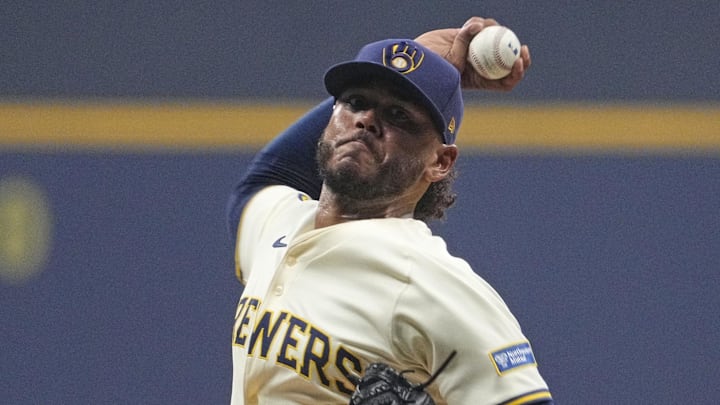The clock is ticking on the Milwaukee Brewers in more ways than one, even more so after their NLCS loss to the Los Angeles Dodgers. Championship windows don’t last forever, and the Brewers are inching closer to a potential transitional period, especially if the high-powered Dodgers continue their recent success over the coming years.
With the offseason only days away, early trade rumors have begun mounting regarding veteran Brewers starting pitcher Freddy Peralta. The Athletic reported earlier this month that the Brewers could “feel compelled” to explore potentially parting ways with the two-time All-Star.
Peralta enjoyed a career season for the NL Central-winning Brewers, going 17-6 with a 2.70 ERA and a 204-66 K-BB ratio in 176 2/3 innings. His 5.5 bWAR ranked seventh among pitchers leaguewide, and his 6.3 hits per nine marked a drastic improvement from his 7.4 H/9 from 2024.
Let’s get the basic information out of the way. Peralta turns 30 next June, and his next team will only need to pay him $8 million hit free agency — assuming, of course, that they don’t force the Brewers to eat some of that money, but it’s hard to see such a request happening over such a small salary. Barring an extension, Peralta will hit free agency next winter, meaning that a team might need to give up significant prospects for a one-year rental.
So, what could a possible Peralta trade look like? Here are some early ideas.
Trade top prospects as the Red Sox and Cubs did for Garret Crochet and Kyle Tucker
When teams are considering acquiring an All-Star player like Peralta, the first thoughts naturally go to the farm system. Boston sent four prospects, headlined by catcher Kyle Teel, to the White Sox last winter for left-handed starter Garret Crochet. Major League Baseball considered Teel the sport’s No. 25 overall prospect, and the Red Sox also gave up outfielder Branden Montgomery (No. 54 on MLB Pipeline), infielder Chase Meidroth, and right-handed pitcher Wikelman Gonzalez. Teel (No. 14, 2023) and Montgomery (No. 12, 2024) were the Red Sox’s most recent first-round picks.
The Cubs gave up slightly less for Tucker, with only right-hander Hayden Wesneski (No. 73) ranking among MLB Pipeline’s top 100 prospects. Chicago also traded third basemen Cam Smith and Isaac Paredes for Tucker, a three-time All-Star in Houston.
The risk here is that Peralta only has one season left, just as Crochet and Tucker did. Crochet signed a six-year, $170 million contract extension last spring, while Tucker remains a pending free agent.
Give up established major-league players like the Yankees did for Juan Soto
Freddy Peralta's 2Ks in the 1st. pic.twitter.com/mqhZcv1uOI
— Rob Friedman (@PitchingNinja) October 15, 2025
It’s easy to forget that when the Yankees acquired outfielders Juan Soto and Trent Grisham from the San Diego Padres in December 2023, they didn’t need to deplete their farm system. Soto, like Peralta, only had one year left before free agency — and, unlike Peralta, Soto was a legitimate superstar and perennial All-Star.
Rather than trade the likes of Spencer Jones or Chase Hampton, the Yankees found a different solution. Michael King was an immensely talented spot starter fresh off posting a 2.75 ERA and 3.3 bWAR in 104 2/3 innings. Veteran catcher Kyle Higashioka was a league-average hitter at best, but he had previously flashed pop and durability. The Yankees then added minor-league pitchers Drew Thorpe, Jhony Brito, and Randy Vásquez to the deal, and that was enough for the Padres.
Vásquez quietly took an impressive step forward in 2025, recording a 3.84 and 2.2 bWAR in 28 games and 26 starts. However, his 78-52 K-BB ratio over 133 2/3 innings, coupled with 16 homers allowed, raises significant questions about his future as a starter.
Try convincing the Brewers to take on multiple, slightly lesser prospects
This is an interesting alternative, and it’s not unlike the Cubs-Astros trade last December. The idea is that rather than give up a top-5 prospect and other minor-leaguers, you’d instead trade multiple top-30 players who are far closer to No. 30 than they are No. 1.
Let’s use the Yankees as an example. At first, the Brewers could theoretically ask the Yankees about infielder George Lombard (No. 1 in their farm system and No. 25 on MLB Pipeline) or right-handed pitcher Carlos Lagrange (No. 2 and No. 74). Instead of immediately declining, the Yankees could offer the Brewers a trade headlined by outfielder Dillon Lewis (No. 16 on MLB Pipeline) and right-handed pitcher Eric Reyzelman (No. 26),
Essentially, the trade would involve quantity rather than quality, and you’ll sometimes see this at the deadline. It’s not the worst idea, and all of these carry an inherent risk. The question becomes whether the Brewers feel they need a team’s top-5 prospect involved to even discuss a potential Peralta trade.
